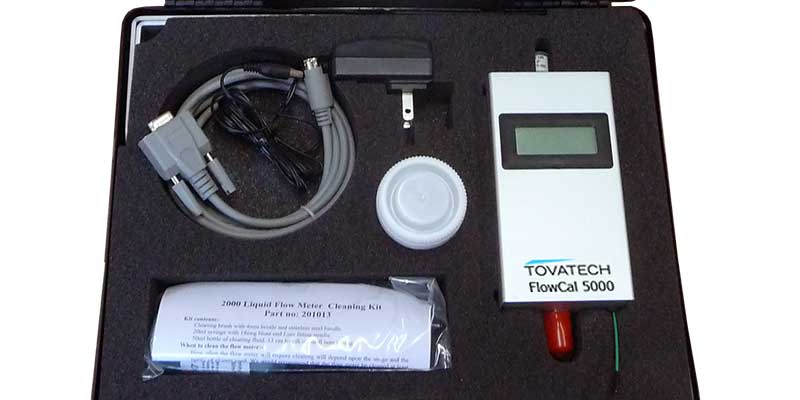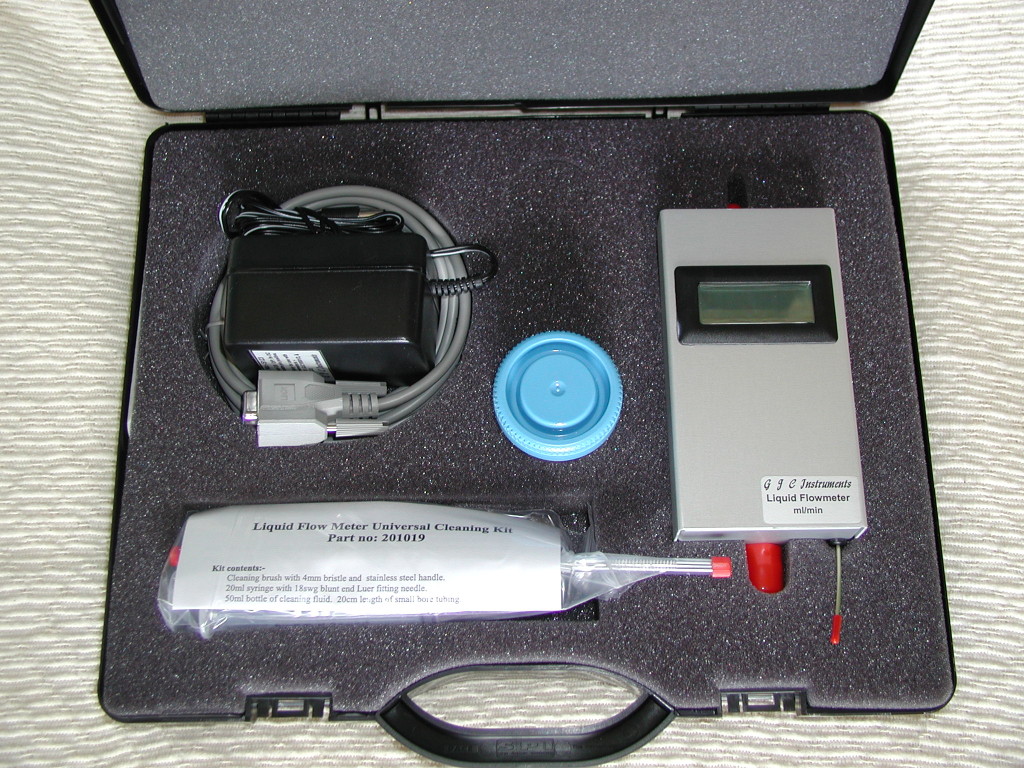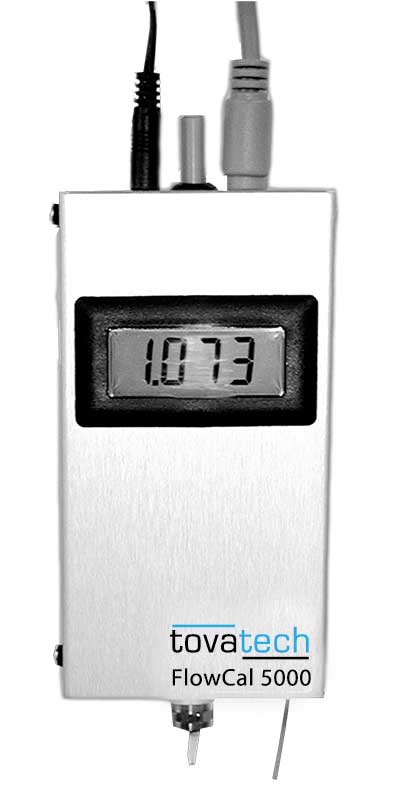
How a HPLC Digital Flow Meter Works
Before explaining how a HPLC digital flow meter works here’s an explanation of what digital flow meters do:
Digital flowmeters performing high performance liquid chromatography are used to measure the accuracy of HPLC pumping systems in order to meet FDA and other regulations regarding installation qualification (IQ), operational qualification (OQ) and performance qualification (PQ) of equipment used in the pharmaceutical and biopharmaceutical industries as well as other analytical labs.
The process demands accurate, reproducible column retention time as an analyte (what is being analyzed) is pumped through the HPLC system.
These precision digital flow meters are not to be likened to flow meters used on process lines measuring flow rates in, for example, thousands of gallons per minute but instead in fractions of milliliters per minute.
Why HPLC Pump System Accuracy is Important
As suggested above, meeting regulations (and protecting a company’s reputation) is the reason. Consistent accurate performance is an absolute necessity. Complicating things is that these pump systems are complex devices that include parts prone to leaks and wear when particulates settle in their components.
Further complicating the topic, we are dealing with flow rate accuracy such as 0.05 to 25 milliliters per minute. This demands care to avoid or at least minimize wear on HPLC pump system components.
But equipment wear does occur and accuracy impacted meaning HPLC pump system testing is required. Here’s where a digital flow meter comes into play and why they should be considered versus traditional methods, which we explain here.
Traditional Methods Measuring HPLC Pump System Accuracy
Manual alternatives for checking these systems are still applied and defined as
- Volumetric (requiring a finely graduated cylinder) or
- Gravimetric (requiring a precision analytical scale)
But the weak point, as we see it at Tovatech, is that both requirements include a stopwatch, excellent eyesight and a high degree of patience on the part of the technician doing the testing.
As an example for volumetric measurement, testing technicians begin to collect HPLC pump system solvent in a graduated cylinder and simultaneously start the stopwatch. When sufficient volume is collected, the flow and stop watch are stopped and the flow rate in milliliters per minute is recorded. This tedious but critical process repeats over and over until a standard deviation can be calculated. Solvent evaporation can lead to measuring errors.
Imagine, if you will, a lab with several HPLC pump systems that have to be tested.
For gravimetric testing similar exercises are performed but using a precision scale or analytical balance to weigh the sample.
One user at a pharmaceutical company reported that they have 100 HPLC systems in their facility. A pharmaceutical industry service supplier tests dozens of HPLC pump systems at several locations. The service representative noted that it takes about 20 minutes to do a gravimetric test.
Replacing these time-consuming error-prone manual methods is accomplished with digital liquid flow meters such as the FlowCal 5000 offered by Tovatech.
How a Digital Flow Meter Works
Finally we get to the topic of this post. Thank you for your patience.
Our example is the 12-oz, compact portable FlowCal 5000 digital flow meter placed at the end of HPLC pump systems being tested. This enables the testing solvent to be collected via a tube from the pump system into the FlowCal 5000 for measuring then directed into in a bottle for later disposal.
Here is the alphabet sequence of operation that typically takes less than a minute for each reading:
- When solvent enters the tube, the meniscus passes an optical sensor that activates a timer.
- When the meniscus reaches a second sensor, the timer stops, a valve opens and the tube drains.
- Readings are displayed on the meter’s four-digit LCD panel and recorded to a six-digit printer or computer.
- The process repeats itself.
Measurement accuracy is ±1 percent of the reading over flow rates of 0.05 to 25 mL/minute. Consistent readings mean the HPLC pump system is operating correctly. Otherwise the HPLC system requires attention.
Going Deeper into How a Digital Flowmeter Works
The FlowCal 5000 has a low internal volume and a rapid reading rate along with high accuracy and repeatability for measuring HPLC system flow rates.
As noted in the ABCs above the principle of operation is the repeated and accurate measurement of meniscus transit time between the two sensors.
Unlike manual methods requiring constant attention (and recording) by the technician, the digital liquid flow meter can be programmed to do as many tests (and record results) as required while personnel attend to other matters.
Installing a Digital Flow Meter
While the FlowCal 5000 is portable, wherever it is used requires careful placement when located in various sections of the plant. Several mounting options are accommodated by the provided mounting kit but all require that the meter be mounted within ~10 degrees of vertical and provide that a suitable collection vessel to be placed below the meter’s discharge.
Options accommodated by the kit include wall-mounting; freestanding; stack system-mounting for positioning it on the front, left or right side of almost any stacked pump/detector system; and a bottle top adapter kit for mounting onto standard wide-necked reagent bottles.
Calibrating Digital Flow Meters
As with any precision instrument such as digital scales, analytical balances and moisture analyzers the accuracy of HPLC flow meters must be confirmed at the outset and checked periodically insure their accuracy is maintained.
The FlowCal 5000 meters are factory calibrated and are shipped with a calibration certificate for a flow rate of 1.0 ml/min. Customers can request additional flow rates. The calibration certificate certifies that the displayed flow rate is within ±1% of the actual flow rate at each calibration point.
Initial Calibration Steps
Calibration points recorded on the certificate result from an extensive process aimed at achieving statistically accurate data by taking, for example, 30+ readings at 0.5ml/min, 40+ readings at 1.0ml/min and 100 readings at 5.0ml/min.
Data are captured and averaged via an RS 232 interface to a PC. The certificate shows the average of these readings at each flow rate. The percent error and percent standard deviation from the actual flow rates are also calculated from these averages and shown on the certificate.
The actual flow rate is determined gravimetrically by collecting a mass of water passing through the flow meter over a recorded period of time. The mass of water is converted to a volume of water by correcting for density based on the water temperature.
The actual flow rate is determined from the volume over time measurements. This is compared to the displayed readings on the digital flowmeter. The firmware of the flow meter is adjusted to allow the displayed rate to match the actual flow.
Recalibration Processes
In accordance with GLP and to comply with other regulations, digital flow meters should be recalibrated annually or if technicians notice a potential problem. Recalibration procedures follow the same format used for initial calibration as described above.
Certified test equipment is required to recalibrate the flow meters in order to issue a new calibration certificate. This is not an easy process and requires a constant flow rate water source. Adjustments, if needed, require access to firmware unavailable to users.
Users should send the FlowCal 5000 flowmeter to Tovatech for recalibration, a process that takes about 14 days. The returned unit is accompanied by certificate of calibration as noted above and details the results of the procedure.
Here is a brief description of the recalibration process:
The flow meter is first flushed with water. Then “as found” (or “before”) readings are taken at 1.0 ml/min to measure the accuracy of the flow meter in the state in which it was received. Customers may request that calibration certificates show “before” data at all the calibration points rather than exclusively at 1.0 ml/min.
The flow tube is cleaned, sensors are checked, any repairs undertaken, and necessary adjustments are made to bring the digital flowmeter into specification. The flow meter is then calibrated to all the customer’s required flow rates. “After” data are recorded on the calibration certificate to confirm that the returned flowmeter is performing according to specification.
4 Steps to Maintain a Digital Flow Meter

Good laboratory practices call for annual flowmeter recalibration as noted above. But improper use of these precision instruments can soon render them inaccurate, thereby compromising fast, accurate calibration of HPLC pumping system flow rates.
Maintenance instructions are usually included in user manuals and cleaning kits shipped with the flowmeters. Here are four tips:
- For flow meters in constant use clean them two weeks in a process that should take about 15 minutes.
- Do not introduce two immiscible liquids into the digital flow meter without either allowing the first to fully evaporate or by introducing a third solvent in which the others are miscible.
- A dirty sensing tube may trap bubbles and create falsely high readings. If bubbles are observed, a quick fix is to turn the unit off, wait approximately two seconds to allow it to drain, then switch it on. Regular use of the cleaning kit will avoid this problem. Do not disassemble the unit.
- Flush the flowmeter with ethanol if it will not be used for a week or more. This prevents algae growth in the tube.
These digital flow meters have been performance-proven in the field as a way to save time and improve accuracy when checking HPLC system pump rates. To quote a comment by a UCLA graduate researcher in chemical engineering “we use the FlowCal 5000 for its accuracy at low volumetric flow rates, reliability and ease of use.”
Contact the scientists at Tovatech for complete details on using and maintaining these precision instruments.

